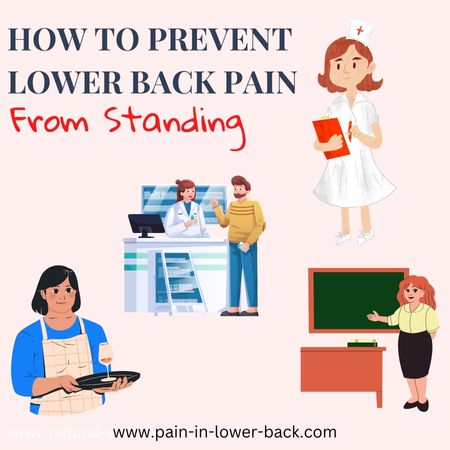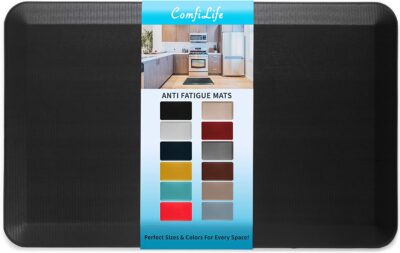Do you suffer from lower back pain after standing for just a few minutes, or longer periods?
Are you worried that your pain will worsen and turn into a serious injury?
A recent study has found that standing on your feet for more than 25 minutes a day could potentially lead to a lifetime of lower back pain.
However:
You don’t have to become a part of these statistics.
Here you’ll find 5 natural and easy ways to prevent lower back pain after standing.

This post may contain affiliate links, at no extra cost to you.
Being on your feet for hours each day is an uncomfortable and painful reality for stay-at-home moms, cashiers, health care workers, waiters and waitresses, pharmacists, mail sorters, assembly line workers, retail salespeople and the list goes on and on.
Standing for a long time can also lead to foot pain, bunions, varicose veins, knee problems, neck and shoulder stiffness, restricted blood flow, and fatigue.
They can all join the “party” at any moment – if they haven’t already.
Overview
Why Does Your Back Hurt After Standing?
Did you know?
Your pain doesn’t necessarily have to do with your age, your weight, or the strength of your back muscles.
Here are the possible causes:
1. Tensed Muscles – muscles have to constantly work to keep you upright. Standing in one position requires some kind of rest, otherwise, the joints from your neck to your feet can become temporarily “stuck”.
The muscles get tired and their tendons and ligaments can get damaged, which means inflammation and pain.
2. Poor Circulation – standing still for long periods reduces blood flow to your muscles. The lack of movement reduces the blood returning to the heart.
This causes the veins to become inflamed and the muscles, which don’t get enough blood supply, start to ache.
3. Footwear – if you stand on hard surfaces (like concrete) and you don’t have the proper footwear (hint: Heels are not a good idea), it can make your pain much worse.
4. Low fitness and Excess Weight – obviously, these will aggravate lower back pain while and after standing.
5. Bad posture – standing often leads to poor posture. As a result, the shoulders slouch forward, the hip flexors are tight, and you have too much arch in your lower back.
6. Overly Tight Hamstrings – this is a little-known cause, but it happens. Overly tight hamstrings can pull on muscles of your lower back and cause muscle pain.
How to Prevent Low Back Pain After Standing
The 5 fixes below can be very helpful, and do not involve medication, shots or surgeries:
1. Best Footwear for Back Pain
Even if you don’t wear heels, just any flat shoes won’t do and they can even make things worse.
You need sturdy, supportive, and comfortable shoes. Shoes that do not fit your feet perfectly can change how you walk and negatively affect your back, knees, ankles, and hip joints.
The worst shoes are high heel shoes, flip-flops, and flat shoes.
The best types of shoes for back support or lower back pain are running shoes, arch support boots, or shoes with special insoles or custom orthotics.

Nurses really like the FIGS 996 Unisex and say they are both stylish and super comfortable.
Alternatively, you can give yourself extra cushioning with gel or foam inserts placed in your shoes.
Rotate your shoes. It takes more than 24 hours for the shoe to recover after you wear it all day.
Have at least two pairs and alternate.
2. Fix Your Posture & Stretch
Stretch your hip flexors to realign your pelvis and stretch your chest to put your shoulders back.
If you have tight hamstrings, you should stretch them every hour or so, ideally.
Here’s a good stretch for tight hamstrings, to immediately relieve your pain:
Also, stand with one foot in front of the other, not side by side. Periodically shift your weight from one leg to the other and try to work with one foot slightly raised (a six-inch/15 cm footstool is ideal).
Here are two more stretches you can do while you work, and are very good for relieving lumbar pain:
1. The Standing hamstring stretch – stand facing a wall and place one foot up on a chair or bench. Keep your knee straight and lean forward, keeping your back straight. Hold for several deep breaths, and then switch legs.
2. The Seated spinal twist – sit on the floor with your legs crossed. Gently twist your torso to the right and place your left hand behind you and your right hand on your right knee. Hold for several deep breaths, and then switch sides.
3. Use an Anti-Fatigue Mat

Using an anti-fatigue mat at work or in the kitchen is a great way to support your lower back. it can help prevent lower back pain by providing cushioning and support for the feet and legs and reducing the amount of pressure placed on the lower back.
The mat can also help improve posture, which can also help reduce lower back pain.
I call it my “magic carpet” because it allows me to stand comfortably while I do the dishes and cook for hours.
The mat is very cushiony but is low enough so it causes no problems in stumbling or tripping on it. Standing on it makes your feet feel like you are floating on a cloud.
It may seem pricy, but if it prevents lower back pain, I’d say it’s worth every penny.
4. Use an Infrared Heating Belt

Thermal therapy is one of the best ways to keep your lower back energized and happy if you stand for a long period of time daily.
A heating belt can increase blood flow to the area, which can help reduce muscle spasms and stiffness. It also helps to reduce pain by relaxing the muscles and decreasing inflammation. Lastly, the heat can help stimulate the release of endorphins, which are natural pain-relieving chemicals produced by the body.
For lower back pain, you can find special belts that can be wrapped around your waist and deliver soothing and therapeutic heat straight to your lower back – some of them can be worn undetected under your clothes.
I own and love my UTK infrared light therapy belt, which uses infrared technology that penetrates much deeper into the tissues, through semi-precious Jade stones.
Why Does My Lower Back Hurt When Standing Up After Sitting (or Bending Over)?
If you suffer from crippling and excruciating lumbar pain when standing up, it probably feels like lightening going through your whole body and you have to hold onto something and stop yourself from moving until it calms down.
Here’s the reason:
Years of abusing your back with poor posture, sitting too much, standing too much and lack of exercise – make the back prone to injury (especially the lower back).
The “technical” causes can be facet syndrome (back sprain), Sacroiliac syndrome, herniated disc, muscle and ligament strain, and Scoliosis.
If your back hurts only when you stand up or bend over, your low back injury may not be muscle related. These symptoms suggest that you may have a bulging disc (usually followed by Sciatica pain – radiating to your legs) or a pinched nerve in your lower back.
I recommend that you be diagnosed properly by your doctor and then come back here to find the best natural and easy way to heal your injury.
To your health and happiness,
Meital
P.S
Here’s The Complete List of DIY Lower Back Pain Relievers

